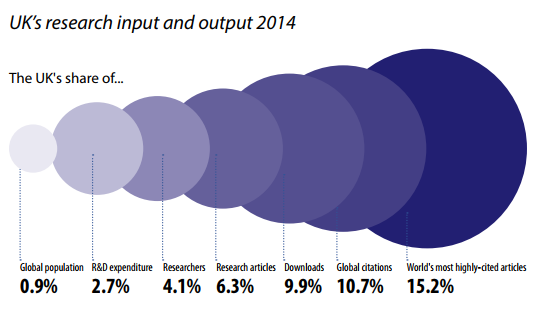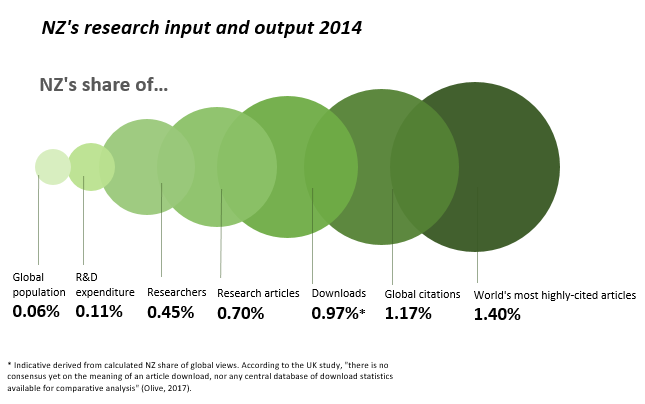How does NZ’s research stack up?
12 December 2017 | news
A recent report highlighted the strong performance of UK researchers in terms of research articles, downloads and citations, relative to global population and R&D expenditure. So, we wondered, what might this picture look like for New Zealand?
The UK analysis comes from the Higher Education Policy Institute (HEPI) report “How much is too much? Cross-subsidies from teaching to research in British universities”.
The author found that with only 0.9% of the global population, the UK was producing 6.3% of research articles and 15.2% of the world’s most highly-cited articles.

Source: “How much is too much? Cross-subsidies from teaching to research in British universities”, Vicky Olive, Higher Education Policy Institute, 2017.
Let's compare this with New Zealand.
As with the UK, our initial analysis would suggest that New Zealand researchers well outperform our small size in terms of global population and R&D spend. We estimate that with only 0.06% of the global population, our researchers generate around 0.7% of research articles and as much as 1.4% of the world’s most highly-cited articles.

This chart suggests that New Zealand researchers stack up against the world's best and is arguably a better indicator of innovative capacity than more narrow output measures, such as patents.
And with our R&D investment (as a proportion of GDP) around 30% below that of the UK, there is the potential for even greater returns to be achieved.
In this context, we welcome the new Government’s objective to increase NZ's R&D spend to 2% of GDP over the next ten years. While tax credits have a role to play and will be of benefit to some parts of the research community, a mix of incentives is important and direct investment in research should remain the prime mechanism for growing R&D in New Zealand. New Zealand university researchers are well-regarded, with around 87% of the 2017 Marsden Fund awards having university staff as principal investigators.
The report also highlights the new finding that “each international student contributes (on average) £8,000 to British research” and the projection that “unless research funding increases, the UK’s regional capacity will suffer badly”.
Links for more information:
- www.hepi.ac.uk/2017/11/09/new-report-shows-international-student-pays-8000-towards-filling-gaps-uk-rd-spending-calls-philip-hammond-invest-1-billion-budget/
- https://royalsociety.org.nz/what-we-do/funds-and-opportunities/marsden/awarded-grants/marsden-awards-2017/
Sources for New Zealand chart:
- Global Population: Statistics NZ population estimates, National Population Estimate 30 June 2014 | Published worldometer world population estimates by year (2014).
- R&D Expenditure: Statistics NZ R&D survey 2014 | World 2014 spend from UK-sourced Elsevier report "International Comparative Performance of the UK Research Base 2016" (page 22)
- Researchers: Statistics NZ R&D survey 2014 plus Ministry of Education/Education Counts tertiary enrolments 2014 | World 2014 researchers from UK-sourced Elsevier report (page 32) [Technical note: Both NZ and world stats include PhD students]
- Research articles: MBIE "2016 Science and Innovation System Performance Report" Table 7 "Field Weighted Citation Impact (FWCI) and volume of publications for New Zealand"| World 2014 researchers from UK-sourced Elsevier report (page 32) [Technical note: Both NZ and world stats based on articles published 2010-2014; both sources based on total volume, not weighted]
- Downloads: According to the UK study, "...there is no consensus yet on the meaning of an article download, nor any central database of download statistics available for comparative analysis..." (Elsevier, 2017, p67). Indicative derived from calculated NZ share of global views alongside exploration of ratio of global views to downloads for UK. (Source of NZ views: SciVal customised report November 2017).
- Global citations: MBIE "2016 Science and Innovation System Performance Report" Table 8 "Total Citations 2010-2014"| World citations from UK-sourced Elsevier report calculation based on statement that "Elsevier articles published in the 5 years ending 2014 were cited 11.5 million times in the same period, meaning Elsevier punches above its weight with more than 25% citation share."
- World's most highly cited articles: MBIE "New Zealand Science and Innovation System Performance Snapshot 2016". Extract "1.4 per cent of New Zealand 2014 publications currently appear in the top 1 per cent of cited publications worldwide (field-weighted)." | World 2014 spend from UK-sourced Elsevier report (page 18) [Technical note: Both NZ and world stats based on 1% of top cited publications]
